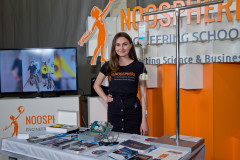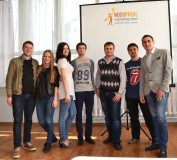Science in Ukraine. Machinery of the National Academy of Sciences

Today is the main professional holiday for all employees of the scientific industry of Ukraine. It is not for nothing that our locations are called scientific and technical laboratories. We believe that it is in interaction with science that it is possible to create breakthrough technologies and implement innovative ideas.
So today we are talking about Science from the general to the specific — from the definition of the concept as a whole, to how scientific activities are organized in our country.
GENERAL THINGS
There are many definitions of science and they are very diverse. We came up with the following:
In the general sense, Science is the activity of a person to learn about the surrounding world, which is expressed in the collection and systematization of the received information. Broader,
Science — a system of knowledge about the objective laws of nature, society and cognition, which are extracted and transformed into the driving force of society as a result of the special activity of people. Also
Science — knowledge of a special type (scientific knowledge) that should meet certain requirements.
SCIENTIFIC ACTIVITIES IN UKRAINE
The most well-known and respected scientific institution we have is the National Academy of Sciences of Ukraine (NASU). The Academy was founded on November 27, 1918, and its first president was the distinguished Ukrainian scientist with a worldwide reputation, Academician Vladimir Vernadsky.
NASU initiates, organizes, and conducts fundamental and applied scientific research in various relevant fields, such as natural sciences, engineering, social sciences, and humanities, with the aim of applying the knowledge gained in society's life.
MACHINERY of the National Academy of Sciences
The Academy consists of three main divisions or sections and fourteen departments, where each individual field is thoroughly studied. The departments are composed of R&D Institutes and other related institutions.
• The section of Physical-Technical and Mathematical Sciences (8 departments, 82 affiliated institutions) includes institutions such as the Ya.S. Pidstrihach Institute for Applied Problems of Mechanics and Mathematics, the M.S. Polyakov Institute of Geotechnical Mechanics, the B.I. Verkin Institute of Low Temperature Physics and Engineering, the Main Astronomical Observatory, and many others.
• The section of Chemical and Biological Sciences (three departments, 43 affiliated institutions) includes institutions such as the Institute of High-Molecular Compounds, the Institute of Sorption and Problems of Endoecology, the R.E. Kavetsky Institute of Experimental Pathology, Oncology and Radiobiology, the Institute for Evolutionary Ecology, the Institute of Food Biotechnology and Genomics, and many others.
• The section of Social and Humanitarian Sciences (three departments and 36 related institutions) includes institutions such as the State institution "Institute of Economics and Forecasting," the Institute of Archaeology, the H.S. Skovoroda Institute of Philosophy, the Institute of Sociology, the V.M. Koretsky Institute of State and Law of the NAS of Ukraine, and many others.
In addition, the NAS (National Academy of Sciences) has institutions under the NAS Presidium, such as:
- National Center "Junior Academy of Sciences of Ukraine"
- State Research Institution "Kyiv Academic University"
- Institute of Mathematical Machines and Systems
- Institute of Telecommunications and Global Information Space and many other institutions, centers, academies, etc.
Let us separately mention the institutions of the NAS (National Academy of Sciences) located on the temporarily occupied territory of Ukraine:
- Crimean Branch of the Institute of Archaeology
- Crimean Scientific Center of the NAS of Ukraine and the Ministry of Education and Science of Ukraine
- Marine Hydrophysical Institute
- O.O. Kovalevskyi Institute of Biology of the Southern Seas
Congratulations to all scientists of Ukraine on this holiday! We wish you lively scientific discussions, confirmation of hypotheses, numerous scientific discoveries, and even more new questions that inspire further research.
Підписуйтесь для отримання останніх новин
Бажаєте реалізувати свій проєкт?
Зв'яжіться з нами і ми допоможемо втілити ваші ідеї в життя!


